|
|
|
PLANETARIUM
- CALCULATORS - IMAGING
|
|
Stellarium
- TheSky - Starry Night Pro - Starry
Night Enthusiast - Voyager - The Guide
Skymap
Pro - SkyCharts / Cartes du ciel - Hallo Northern Sky - ExInEd
- Redshift
Virtual Sky
- Celestia - Virtual Moon Atlas - Dance
of the Planets - PRiSM - Distant Suns
Deep Sky 2000
- Alpha Centaure - The Earth Centered
Universe - Desktop Universe - Nuit
HF
Propagation programs - Ham, DSP and satellite tracking software |
|

Conjunction between Moon and planets

Moon eclipse

Mars at perihelic opposition

The
Virgo cluster of galaxies
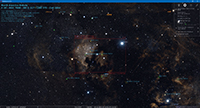
Using
the DSS catalog, the
field
of NGC
7000 in a 80 ED refractor
and a Nikon D7000 DSLR

The
Coma cluster in a C8 f/20 scope
and
a 31 mm Nagler eyepiece

The setup of plugins
(e.g.
add orbital elements of comets)

The setup of plugins
(e.g. add TLE of satellites)

The
ASCOM interface

Stellarium
guiding on M31

The
sky in Stellarium web
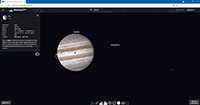
Transit of Io in Stellarium web
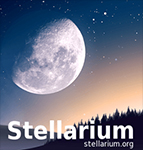
(c)
2004-2021
Stellarium,
Shareware
|
Stellarium    
Stellarium is
a free software or more exactly a shareware (because you can donate them
some money to support their efforts) that uses an intuitive and user-friendly
graphic interface. Since its first release in 2004, it is very appreciated
by amateur astronomers but also by professionals who find in it a powerful
tool to simulate astronomical events in the past, present (in real time or
fast pacing) or in the future, specially educators and science historians among others.
By default,
Stellarium can display more that 600000 stars but extra catalogs allow to display
up to 177 million stars up to magnitude ~18. There are over 80000 deep sky objects
(DSO) and in option you can add extra catalogs including more than 1 million DSO.
Stellarium also displays asterisms and illustrations of the constellations for more
than 20 different cultures, pictures of nebulae (including the full Messier,
NGC and IC catalogs), major galaxies including clusters of galaxies, the Milky
Way, and a very realistic atmosphere, sunrise and sunset glows, and of course
planets and their moons. If needed you can download parameters of all
existing comets and asteroids (via F2, Plugins, Solar System Editor,
Confure...) but have at your disposal several gigabytes of free disk
space.
Stellarium
can simulate the sky in the past or in the future but with limitations.
According to the Stellarium User Guide 2017, Appendix
E, thanks to VSOP87 analytical ephemeris model (via F2) that matches
with the run DE200 from NASA JPL, you can simulate the sky between 4000 BC
and 8000 AD with accuracy. But for most planetary events, you
can only get the highest accuracy (about 1") for the last 2000 years
or even less : between 500-3500 AD for Galilean satellites, between
1826-2047 AD for the Earth's Moon, and between 1885-2099 AD for Pluto (cf.
Appendix E page 294).
Outside
these ranges, the excessive extrapolations don't give accurate positions
(don't try to simulate a celestial event like an solar eclipse or a transit
50000 years in the past or you will probably miss it !).
Knowing
its relative limitations, Stellarium is very impressive by its ability to
simulate without apparent slowness the movement and the aspect of almost any
kind of celestial body in high resolution.
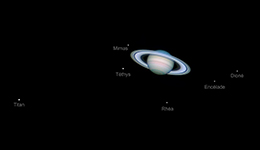
|
 |
| At
left, picture of Saturn and six of its satellites taken by Jamie Cooper on January 26, 2006 with a Celestron Schmidt-Cassegrain C14 telescope 356 mm f/10 equipped with a webcam. It is the stacking of several color photos.
At right, the simulation with Stellarium by the author. |
Once downloaded and installed, you need to enter your location (or later
via F6), adjust your time zone, and select a background panorama. You can also replace
that panorama with one of the many provided by users (cf. Landscapes)
or use your own panoramic HD picture that you will copy in a subfolder of
\landscapes in Stellarium in PNG format 2048x275 pixels (via F4, Landscape. See
this tutorial on YouTube).
Optionally
you can configure via the menus F2 (Display) and F4 (Configure), tens of
secondary parameters like the language, the brightness of the sky glow,
the brightness and scintillation of stars, the limit magnitude of stars,
the frequency of meteors, labels (size, color, density), display pictures
of DSO, the location of pulsars, novaes, quasars, exoplanets and add
catalogs of tens of others deep sky objects (M, IC, NGC, Abell, PGC, UGC, ESO, etc).
To
be up-to-date, in addition you can download from external sources,
additional data like orbital parameters of comets and asteroids (via F2,
Plugins, Solar System Editor, Configure) and TLE of artificial satellites
(via F2, Plugins, Satellite, Configure), and ask to display them at
startup or not.
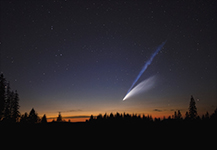
|
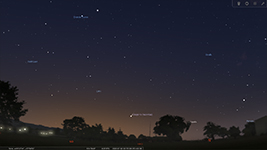 |
| A
left, the comet Neowise (C/2020 F3) pictured by a member of ASA
Astrosysteme on July 12, 2020 by ~23h UT. At right, the simulation
with Stellarium by the author. |
You can also display the outlines of the constellations
or only their name or even the drawing of the constellations. If need you
can change you location via F6. These parameters are saved as your default
settings (via F2). The location of your configuration
files depends on your platform (cf. also the wiki).
By
default, Stellarium displays the sky for the current location and time and
optional for all activated data, e.g. DSO, meteor showers, and plugins like
satellites, comets, asteroids, extra catalogs, etc. Thus, the default
application loads much faster than a version loading tens of catalogs
gathering several gigabytes of data.
If needed, you can
disable these plugins via the icons displayed at the bottom of the screen or even
remove extra catalogs.
At
any moment, you can change the time from the panel display at the bottom left (via F5).
Then, according to your needs you can use the bottom panel to select or unselect additional
objects (planets, DSO, satellites, etc), track them, etc.
|

|
 |
| At
left, the Halley comet close to quasar NGC 5128 simulated by the author with
Stellarium pictured (overexposed) by A.Gomes from CTIO
on, April 15, 1986. At right, the simulation for April 14, 1986 at 12h UT as seen from
CTIO in Chili. It is the best match that we got. We investigated the reasons for which
there is a small difference of position and were unable to match at 100% with the date
of the picture (took ~12 hours later). According to Stellarium developers it could be
explained by the fact that we used recent orbital parameters and not those for April 1986,
and also by the variable amount of dust and gas ejected by the comet that slowly modify its orbit. |
When
selected (via the I key), the built-in DSO images being not saved in their
highest resolution and are compressed to prevent using too much space on
disk, at high zoom or magnification, their medium quality
becomes apparent. So you cannot really zoom and explore the Milky Way
richest star fields, HII regions or the clusters of galaxies of Coma or
Virgo as if you were at the eyepiece of a scope. However, Stellarium
provides a good start to prepare a possible night session.
If
you plan to observe the sky through a scope, Stellarium provides a telescope
view mode that simulates the field of view of your scope with the selected
eyepiece or camera (but you need first select an celestial object then go
to the upper right panel and select the tool). This function also supports binoculars.
This
tool is also useful to check the field of view of your optical system on
that celestial body before starting your session or before planning the
purchase of that specific eyepiece, scope or DSLR or CCD camera.
|
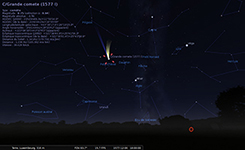
|
 |
|
Simulations
in the past. At left, the Great Comet simulated by the author with Stellarium for December
6, 1577. It is located in the Little Horse as displayed in Cornelius Gemma's
illustration in his book
"De prodigiosa specie, naturaquae
cometae" (after page 66). At right, simulation of the conjunction between
Venus and Jupiter on August 12, 2 BC at 3:15 AM local time in Bethlehem in order to find
a celestial event that could explain the "Star of Bethlehem". See other
simulations in this page
written in French. |
At
last, Stellarium can control the mount of a telescope thanks to the ASCOM
interface. In that objective, Stellarium provides a night mode (a red
screen via Ctrl+N), and in addition, you can adjust the brightness of stars.
When all connections are established a pointer "Scope" is
incrusted in the current view showing where the scope is pointing.
Stellarium
is available for Windows 7 and above, Mac OS X 10.12.0 and
above, and Linux. It requires a computer with a 3D graphic card supporting
OpenGL 3.0 and GLSL 1.3 or OpenGL ES 2.0, 512 MB RAM and at least 420 MB
on disk (plus enough space for the tens of extra catalogs). The download
of some catalog can last several minutes, even using a fiber optics
connection at 100 Mbps (12.5 MB/s).
There is also
a nice and intuitive web version : Stellarium-web.
A
support is available on line to SourceForge.net.
The Stellarium User Guide is available in HTML
and in PDF format published in 2009
and 2017.

|
|




(c)
1984-2020
Software
Bisque, $99-$349
|
TheSky     First
released in 1992 by Thomas M. Bisque, with time this famous program became
a reference product, on par with "Starry Night Pro" and a few others.
The
graphic interface as the contents of TheSky were already nice and
very complete in its older versions - among the best available at that
time - and have till improved in TheSkyX. It deserves well its 5 stars.
TheSkyX
Professional has been redesigned from the ground up, and includes numbers
of new exciting features (Eclipse Viewer, Conjunction Finder, 3D Solar
System View, Field of View indicators (FOVIs), etc).
As its challengers, TheSkyX Professional Edition, includes
all you think about to prepare a serious observation session, visually or
driving automatically your scope at a key depress.
This
latest release can simulate any sky map between 4712 BC and 10000 AD with
accuracy. It includes Hipparcos and Tycho stellar databases
including b-v indexes, the 19 millions objects from the Hubble
Guide Star Catalog to magnitude 15, the 73197 galaxies from the
Catalog of Principal Galaxies (PGC) which shows their minor and
major axis and orientation plus all NGC/IC and Messier objects and at last
13000 thumbnail pictures. It can load external catalogs on
CD-ROM as the USNO A2.0 database with 526280881 supplementary stars or
its equivalent on the web in the case of the millions of objects
displayed should not be enough !
You
can also customize the panorama thanks to eleven built-in scenes
(desert, forest, lake, island, mountain, including from Mt. Wilson and
VLA).
The
SkyX (three upper screendumps) and even TheSky6 ( below screendump)
include many improvements, displaying the starry night with still more
realistics images. All settings can be configured to suit to your needs. The
stars are optionally displayed in color for those stars that contain
the spectral information, the brightness and the intensity of the
colors for the spectral types are also user definable. The stars
plotted magnitudes are scaled according to the zoom level.
The daytime
sky mode is pleasant to view, the moon phase calendar and its appearance
have been improved too as the object information dialog box, the
Dreyer descriptions for all NGC and IC objects, the astronomy tutorial, to
name a few.
On
robotic side, the program is able to drive any telescope including Dobsons
or the Nexstar5 with Autostar and offers the ability to display the
field of view of the ST-4X guiding CCD detector as many finders.
TheSkyX
Professional adds $150 extra over the Advanced version because it can be
interfaced with other Bisque programs like CCDSoft (whereas Advanced version
does work with Tpoint) providing automated scripting, astrometry
measurements, telescope pointing analysis and till more, and it comes with
many additional databases not included in the Advanced version. As
its competitors, update files can be download from the publisher
website.
TheSkyX
is available for PC, Mac, Lunix and Raspbian systems in several versions :
Student, Serious Astronomer and Professional editions. It requires a 1.5 GHz
or faster processor, a minimum of 512 MB of RAM, 2.5 GB of disk space, a 1024x768
pixels monitor, and a CD-ROM. A version is also available for Apple
mobiles (iPhone, iPad, iTouch) but not for Android plaforms. There is no
demo version.
Software
Bisque provides support
to customers via their Community forum and their Knowledge base.
Unfortunately, if you don't find any answer online, they will ask you $100
per incident, 30 to 50 % of the product price ! It is the first time
that I see a company providing software to amateurs that charges for their
support. This price is not justified and prohibitive !
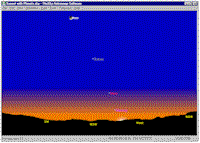
|

|
|
TheSky version 5 (1998) on a VGA screen. |

|
|


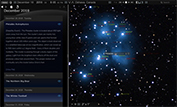

(c) 1991-2020
Siennasoft,
$50-$250 |
Starry
Night Pro    
Thanks
to its graphical performances, this very complete program displays the sky,
celestial objects and events in a realistic way. You can also edit the horizon to add
trees and create hills or load a picture. It is a huge package including all
options that an advanced amateur astronomer is in right to wait for.
As
said Sienna this is for serious astronomy... but funny one too. Starry
Nigh Pro comes with the complete Hipparcos/Tycho stellar database and its
16 million stars with b-v indexes, over 19 million
objects from the Hubble Guide Star Catalog to magnitude 15 and includes
the 73197 galaxies from the Catalog of Principal Galaxies (PGC) which
shows their minor and major axis and orientation, Tully database with its
3D positions of 28000 galaxies, and of course last but not least all NGC/IC
and Messier objects. To complete these options a custom image layer help you
to add external CCD images or digitized photographs. So far, no other
planetarium software provide this option.
You can
also set the limit magnitude for each catalog separately, and easily select
any object to determine its rise, transit and set times, magnitude and position
in several coordinates systems.
Starry
Night Pro is also an powerful educational tool. Its requires QuickTime to display
multimedia features as movies of sky animations, planets flybys, liftoff's and more.
Among its
most amazing tools you may quit the solar system and observe the nearby stars
in 3D, travel anywhere in the universe up to 700 millions light-years, display
dynamic Hertzsprung-Russell diagrams, create alien planets with customizable
surfaces details and satellites, add custom horizon panoramas, edit orbits
to add or modify planetaries objets.
If
you like historical simulations, you can go 99999 years in the past or in
the future, speeding up or slowing down time.
The
Internet links are everywhere present; connecting to LiveSky
you can for example display information about planets, stars or constellations or
download DSO pictures connecting to the Digitized
Sky Survey database.
Starry
Night Pro is able to create artificial satellites reading their 2-line elements
or to track them. In the same way it is able to track comets and asteroids.
At
last, the program is able ASCOM compliant and able to drive any
telescope but its controller looks to light and display weakness
to consider it as a serious tool. On-line support is fast and update
release can be downloaded from the publisher
website.
Starry
Night is now at version 8 PLUS and is available for Mac and PC computers and runs on all
32 or 64-bit platforms. It is available in two versions, Pro and Pro Plus.
There is no demo version.
Starry
Night Pro 8 version requires a 1 GHz or faster processor, 1 GB RAM
and 12 GB of hard disk space. A fast video board is required as OpenGL support
requires a 128 MB OpenGL 1.4 capable graphics card (OpenGL 2.0 is required
for features like shaded sky, animated grass and fast AllSky rendering at
wide FOV).
Good news,
contrary to its main competitor, all users and prospects can
question their support
team free of charge.

|
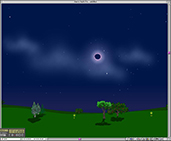
|
|
Starry
Night Pro v3.1 (2002). Documents WAP. |

|
|
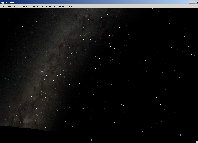

(c)
1991-2014
Siennasoft,
$80 |
Starry
Night Enthusiast    This
package is voluntary lighter than the Pro version. It replaces the old
"Starry Night Backyard" version and comes with a totally
redesigned GUI much more attracting and faster.
This
version is created for the casual observer or the one who doesn't use a
telescope with tracking capabilities. It takes advantage of the same
engine that the Pro version, the same intuitive interface with multimedia features that
require QuickTime. It is able to display a variable sky brightening
including light pollution and details in the Milky way.
This
version gathers all you need to learn astronomy. All the planets and most
moons are displayed with high resolution surface rendering and you have
the ability to add new objects (comets, asteroids, moons, planets and even
satellites) using the built-in orbit editor or to change surface map of
planets.
Like
the Pro version, this version is able to manage artificial satellites
reading their 2 line elements (Keplerian elements).
This light version has at its disposal a reduced number of
stellar and deep sky objects : 2.5 million stellar objects and 40000 DSO.
You are also limited in travel in time between - 4713 and +9999 and you
cannot select a custom horizon panorama.
Contrary
to the previous Backyard version, this new version has built-in background
landscapes. It can print advanced sky charts showing deep star fields and
DSO. The Enthusiast can link out to LiveSky for the most
up-to-date information about them. Here also all update release notes can
be downloaded from the publisher website.
Starry
Night Enthusiast is now at version 6.0 and runs on all Windows 32-bit (it
was designed for XP first) and MacOS platforms using a 500 MHz or faster
processor, 128 MB RAM and 900 MB of hard disk space. On slow computers the
OpenGL will not initiate and some optional features will not be displayed on screen
A
trial version is available from Starry
Night Store. A trial version of "Starry Night Backyard" is available from
Download.com.
Good
news, all users and prospects can question their support
team for free.

|
|



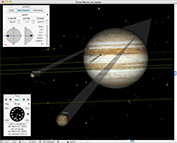
(c) 2009-2014, $99-180
Via Carina
Software & Instruments
|
Voyager   
This
planetarium software displays the sky and celestial objects in a realistic
way. It can simulate the aspect or the movement of celestial bodies or any
celestial event like conjunction, moon and sun eclipses, transits of
planets and moons, and more.
The
full database can display 155 million stars from the NASA's SKY2000
Master Star Catalog, including their
magnitudes and physical properties.In addition, the older Hipparcos,
Tycho-1 and Tycho-2 catalogs are available. The basic version includes 2.5
million stars to magnitude 12.
Voyager
can also display 1.6 million deep sky objects
(DSO), 400000 asteroids, 2900 comets, planets and their moons,
104000 multiples systems (including the Washington Double Star Catalog),
over 2000 binary stars, all meteor showers, and the trajectory of
1100 man-made satellites and spacecrafts.
Optionally,
you can download/import the latest orbital data for comets and asteroids
from the Minor Planet Center
as well as TLE
(two line element) to display positions of artificial satellites with high
accuracy.
A
startup file is saved locally to show for example the the sky over
your location at the current time. The file is preserved between versions.
Voyager
provides several panoramas that you can use for the background (lake,
forest, rocky, beach, etc) or you can create your own horizon. However the
blending at the horizon or the separation between terrestrial objects and
the sky could be improved.
The
magnitude limits are adjustable, with a limit of 18.0 for stars and ~20.0
for DSO based on the field of view.
You
can also configure how Voyager 4.5 displays stars (brightness and
saturation). You can also filter the display of stars by spectral type or
luminosity class.
The menu
is made of dialog boxes, small windows containing tens of icons and
controls to access rapidly to all main functions. Their aspect could be
improved. Clicking on any object
with the mouse, contextual data can be displayed too.
Voyager
displays updated high-resolution pictures of the Earth, Moon, and other
planets taken by spacecrafts. Planets and moons are rendered realistically
based of images from Clementine, Magellan, Mars Global Surveyor, Galileo, and Cassini missions.
Voyager
displays planets, rings, moons and their shadow taking into account the
effects of perspective and rotational flattening.
Voyager provides animations of many celestial events : solar and lunar
eclipses, spacecraft encounters with the major planets, rare shadow transits on Jupiter and
Saturn, the changing shape of the constellations over tens of thousands of
years, a journey around the Pleiades and Hydes star clusters, precession of the celestial pole over its
26000 year cycle, and the orbits of the newly discovered dwarf planets in the outer solar system.
In
addition, Voyager can display the sky from another locations, including
from another planet or from space. Voyager
uses the precession to extrapolate lunar and planetary positions up to
500000 years in the past and in the future but the highest precision
(matching JPL data) is limited within 10000 years. Voyager includes support
old calmendars too (Hebrew, Islamic, Persian, Indian, and Mayan
calendars).
You
can print start charts, and create observing lists suited to your
telescope. Voyager can control most GoTo mounts via the RS-232 serial port
or via an USB port.
Voyager is now at version
4.5 and has much improved from version 3.75 and 4.0. It runs on all 64-bit
platforms from Windows 7 and Mac OS X 10.10. Upgrades are also available
but the demo is no more available.
The product can be
downloaded or sent on two DVDs or two CDs.
The
company also sales a software to exlore the sky named "SkyGazer".

|
|


(c)
1999-2016
Project Pluto,
$40-45
|
The Guide   
This
low-cost desktop planetarium program is an excellent software, a true
challenger for its competitors.
The
Guide is able to display a view of the sky full customizable, including
the horizon and objects fixed on it. You can also fix the limit magnitude for each catalog
separately and generate charts from 180° to 2 arcminutes wide. Among the
most amazing catalog available, the Guide reads the RealSky CD's or
the Digitized
Sky Survey for DSO and the Clementine Moon database providing stunning high resolution pictures
of lunar formations (CD-ROM Vol.15 from NSSDC provides a resolution up to
0.5 km/pixel, CD's 1-14 up to 100 m/pixel).
In
addition you can switch between the default display mode showing the north
at the top and west at the right to an inverted view similar to the one
you see once the eye at the eyepiece.
The
accuracy of the Guide is similar to other quality products, computing for
example planetaries positions to about 0.01" using the VSOP and
PS1996 theories. In the same way, it computes the Moon position using the
ELP theory and Lieske's E2x3 theory for the satellites of Jupiter.
In its
details, the Guide displays the shadow cast by satellites on their planet,
isophotes of nebula, eclipse path, stars occultations by asteroids and
other transits in full details. Regularly updated, upgrades can be downloaded from the
publisher website.
The
Guide is now at version 9.1 and runs on all Windows and Mac OS/X platforms

|
|
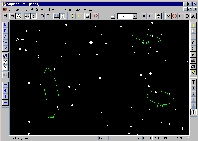


(c)
1986-2000
Chris
A. Marriott, $99
|
Skymap Pro  
In
my humble opinion, this program has been at
a few steps to become a reference if its realism and refresh should have been
better. In an unrealistic way if you zoom in for example to approach of your
target sometimes no more stars and objects appear. Or if you zoom out
fainter stars continue to be visible. You have to add or suppress dim stars
manually by clicking a button. Stars are all white displaying a large
white surface without much differentiation of their brightness. Positive
side, clicking on any star or object Skymap Pro displays information like
its magnitude, size, some astrometric and photometric data plus some
catalog references. A barred filled dot symbolises multiple stars and a
barred empty dot the variables.
Except
this curious way to display stars Skymap Pro is really complete up to include a
remote telescope controller called Autotrack (not tested).
The
planetarium screen is ergonomic, the left and upper task bars displaying
icons to quickly access to various functions. The display is customizable,
from the colors of all components to the inclusion or not of various grids
and toolbars.
Skymap
Pro display ephemerides between 4000 BC and 8000 AD. It accesses to various external catalogs listing multiples stars, asteroids, comets and DSO,
locally stored on CD-ROM's (stellar databases or images, including in FITS
format) or from external sources like the DSS
website.
The
Planning and Tools menus are short but will help you to find the moon
phase, calculate the canon of eclipses,
daily events and edit an observation log. Among the tools available the
Search menu allows you to quick find any celestial objet knowing its name,
not necessary the constellation, its bayer letter or its propre name.
Among the objects to insert you can project the true field of
your best finder (Telrad) or eyepiece on the celestial sphere. You can
also insert text, line, circle or even a camera frame but their size has
to be fixed before displaying.
Skymap
Pro can read Two Line Elements files (TLE) to display trajectories of artificial
satellites in front of the starry night (do not confuse with SkyMap 6.4 from Rod
Matson dedicated to satellites tracking).
If
most of bugs from the previous release came from the video driver, the new
version solved those problems. Skymap Pro is now at version 8.0 and runs fine
at the resolution of 1024x768 pixels and 64k colors on Windows 95/98/ME/NT 4 or
2000 but requests only a 133 MHz Pentium, a SVGA display and 32 MB RAM.
NB.
The
third screendump was extracted from the release 6 for comparison purposes.

|
|


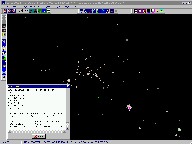
1998-1999
Astrosurf,
Freeware
|
SkyCharts
- Cartes du ciel  
This
is the first swiss product I know written in french but able to easily switch to...
20 other languages including Catalan ! An excellent job from Patrick
Chevalley.
SkyCharts
- Cartes du ciel - is easy to use and quite complete. Its
advantage is to be colorful, displaying true color of stars and objects.
Stars brightness and aspect can be customized.
The
menu is ergonomic displaying a serie of icons on the upper and left
side of the screen to access functions. By clicking any object the program
displays a short or an extended legend (its name, type, magnitude, size,
b-v index, etc). You can easily find an object by its name, its
coordinates or pointing quickly an area on a star chart.
It
includes various catalogs compiled in short versions for convenience and
use by default the 9096 stars up to mag 6.5 from the Bright Star Catalog, Sky2000 Master, NGC
objects and 10000 nebulae from SAC 7.2. It lists
107 comets, 40 asteroids and can manage the General variable stars catalog and
the Washington Double star catalog too. You can also access external
databases on CD's or on the Internet like Tycho, GSC, USNO-A, Lynds, 3C, PGC,
RealSky, ESO Skycat DSS2, Lowell Comet and Astorb catalogs, etc. The
latest release includes the location of Iridium flashes and of course the
trajectories of hundreds of artificials satellites.
A complete
on-line help explain the reasons of selecting such or such catalog and
provide links too as for example to HEARSARC
SkyView to dowload a sky image corresponding to the current chart. A
similar option is available to display galaxies, loading their images from
CD's (DSS or IRAS) or the Internet in order to merge them in the current
chart.
The
rendering of galaxies surface is pleasant. Better than simply displaying
an empty shape, SkyCharts uses the Third Reference Catalog of Bright
Galaxies to displays an orange-yellow to greyscale surface according the
brightness of the DSO and its nucleus.
Sky
Chart is able to display proper motion of stars in 9999 years and display
the sky until year 3000. You can save your configuration, print charts or
merge images of various format on your sky charts too.
At
last it includes a plug-in for Meade telescopes. The interface can
be used with LX200, Autostar, Magellan I/II and other systems using the
LX200 protocol.
Due
to all these options and the fact it is a freeware, I give it one more
star that what I expected from this program.
SkyCharts is now at version
2.71 and runs on Windows 32-bit but not as fast as its competitors. A
complete html help file is provided.

|
|
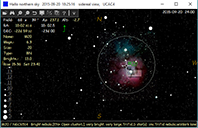

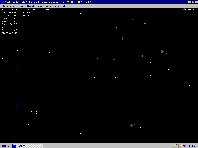
1998-2021
Han Kleijn, Freeware
|
Hallo Northern Sky   I
appreciate first HNSKY for its ergonomy, the ease to change parameters
and for the display of the target parameters in the upper left of the screen.
Positive side while you zoom in more faint stars appear, not always well
differenciated, but this is a performance to highlight as it is not always
programmed in freeware products. At any moment you can bolden the star
appearance and reduce or extend the limit magnitude. Counterpoint, when zoom
out, all faint stars continue to be displayed, whitening your screen. You
have to reset the limit magnitude to get a more realistic sky.
HNSKY
displays the objects of the solar system and their major moons with surface features.
The comet and the asteroid databases can be updated online with just one click.
The position of asteroids is calculated with an accuracy of 1" up to
10 years in the past or in the future. To calculate with a very high accuracy planetary
positions, the program can use JPL Development Ephemeris like
DE431 covering years 13000 BC to 16999 AD.
HNSKY
can access to star databases
up to magnitude 18. It can access to online extra star databases like GAIA DR2, UCAC4,
NOMAD and PPMXL catalogues or you can download the USNO UCAC4 catalog up to
magnitude 16.
Double stars have not been forgotten and the double-double
epsilon Lyrae-1 appears well when the true field decreases below around 18' and magnitude below 8.
HNSKY
includes
30000 deep sky objects and provided also hundreds of DSS deep sky images
that are blended in at the correct size and orientation. The download of
additional DSS images via the Internet is fully integrated. Just select
an area and select download. After a few second the DSS image will blend
in the HNSKY map at the correct size and orientation.
By
default, DSO are displayed not as empty ellipses but are filled, showing a grey
surface a bit similar to the Catalog of Principal Galaxies to simulate their
appearance at the eyepiece.
HNSKY
provides a Search tool to find planets or their satellites, stars, constellations,
DSO (Messier, IC and NGC) but also a hundred comets and so many asteroids.
HNSKY
also uses a powerful animation menu and an integrated deep sky observations help file.
The
zoom is also powerful. You select an area with a right-clic of the mouse to center
it and you zoom by clicking on the IN or OUT menu.
There
also two very useful tools. First the fact you can move around the sky
using the arrows. Even displaying all objects the refresh is very fast.
The second tool is the accelerated motion which is available using the F
key.
Very useful to find a conjunction or the accurate position of an asteroid
for example among stars.
At
last, HNSKY works fine with programs like EQMOD and MaximDL. It
can also control any telescope using the ASCOM interface.
HNSKY
is now at version 4.1.30 and runs on Windows, Linux and Rapsberry Pi
platforms.
The
two last screendumps are extracted from version 2.04.

|
|

1996,
ExInEd,
Freeware
|
Exploration
in Education  
These
are educational electronic publications produced by a dedicated team of the
Special Studies Office at the Space Telescope Science Institute.
Their objective is to increase the educational value of space
exploration.
Products
available cover all kind of subjects, from the space exploration
(Apollo11, Magellan-Venus, Mars,...) to Earth study (Hawaiian
volcanism, teledetection,...) or deal with pure astrophysical
matters (Cepheids, results of GHRS, etc).
Require
installing a WinPlus runtime to read Stack files (.STA).
ExInEd
runs on Windows and MacOS platforms.

|
|
NOTE:
Due to the JPEG compression, colors of screen dumps are poorly rendered and
do not pay tribute to the work of their authors...
|
Software
reviews are also available on the following websites :
ASTROSURF - SKY
& TELESCOPE.
|
Back
to Reports & Reviews
|